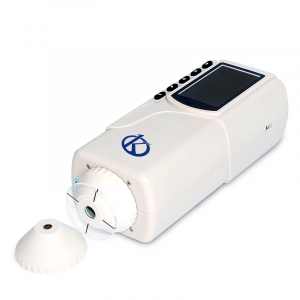Colorimeters are equipment used to measure and analyze colors, through measurements “tristimuli” that are based on the passage of light through the three primary filters, red, green and blue, providing information on the amount of these three colors present in light reflected or transmitted by a product or material. There are two types of colorimeters: color densitometers, which measure the density of primary colors, and color photometers, which measure reflection and color transmission.
These innovative devices provide highly accurate results on the intensity and hue of a color, with a lamp that projects a ray of light onto a particular object, enabling them to easily identify color, compare colors and hues, measure color intensity, measure color robustness, perform color quality control, reference source to determine color standards, and evaluate batches of non-metameric colors.
What are the color meters?
Colorimeters carry out quantitative and qualitative measurements of colors, including parameters such as saturation, hues and luminosity, as well as perception, quantity and depth, based on the Beer-Lambert law, according to which the absorption of light transmitted through the medium is directly proportional to the concentration of the color light medium to the measuring device. This analyzes the color compared to an existing standard, and then a microprocessor then calculates the absorbance or transmittance percentage, so the computer measures the absorbance or transmittance percentage, both measures of how much light of a particular color is transmitted by an object or solution.
The radiant energy of the light source is influenced on the object or solution, the reflected radiant power passes through one of the three tristimulus filters and falls on the photodetector, generating a response proportional to the corresponding tristimulus value of the object-source combination; subsequently, these raw data are transferred to a microprocessor for the calculation of the absolute tristimulus values. That is, the colorimeters determine the color as a function of the red, blue and green components of the light absorbed by the sample object or the amount received by the human eye, when this light is projected from the equipment, affecting the sample, and part of the light is absorbed, causing a decrease in the amount of light reflected by the sample. The colorimeter measures how much light the sample can pass through as well as how much light is not absorbed. The sample is then tested to determine accurately its level of absorbance.
Where are the color meters used?
Colorimeters are very versatile equipment so they are used in research and development laboratories, allowing to design electronic equipment, such as phones, TV, tablets, monitors and computers. They are also used in the toy, textile, paint and other product industries to verify that colors are maintained during the production process. They are today especially employed in the graphic and digital printing industries.
They are also widely used in clinical laboratories, pharmaceutical and histological laboratories, where they are used for color quantification and biochemical and microbiological tests. Colorimeters can also be used in quality control for production lines or food.
What does Kalstein offer you?
Kalstein is a manufacturer of medical and laboratory equipment of the highest quality and the best technology at the best PRICES in the market, so you can make your PURCHASE confidently with us, knowing that you have the service and advice of a company specialized in the field and committed to provide you with safe, economical and effective options to perform your functions in the right way. That’s why we present our.
This device is a high-grade instrument with an 8/d structure that is very precise. The 8mm measuring aperture makes it popular in many applications, such as fabrics, paper, plastic parts, construction materials. CSCQ3 software helps to perform color difference analysis, cumulative color difference analysis, chromaticity index, color sample database management, object color simulation. For more information we invite you to take a look HERE


